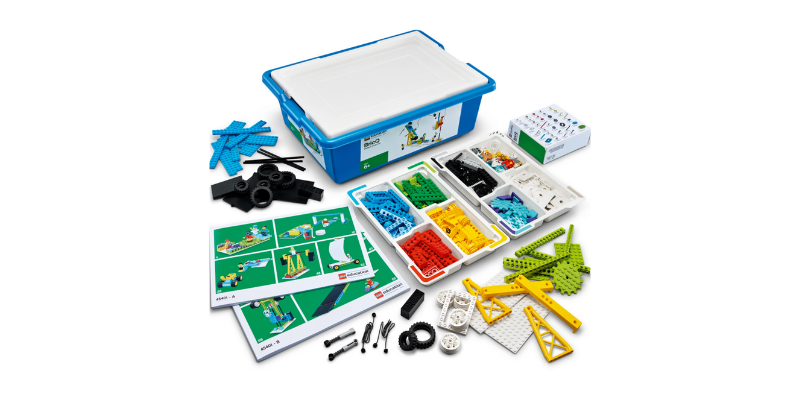LEGO® Education BricQ Motion Essential’s Train to win unit offers an exciting and engaging way to teach young students about balance and gravity through a hands-on project: the Tightrope Walker. This lesson is designed for students in grades K-2 and aims to foster an understanding of essential scientific concepts while developing teamwork and problem-solving skills. Let’s delve into how this K-2 science lesson plan unfolds, ensuring a comprehensive and immersive learning experience.
Preparing for the Lesson
Before diving into the lesson, it’s crucial to review the online student material thoroughly. Utilizing a projector to share these resources with the class can enhance engagement and understanding. Ensure that the foundational concepts, such as balanced and unbalanced forces due to gravity, have been covered in previous lessons. This background knowledge is important for students to grasp the core ideas of the Tightrope Walker activity.
Consider the diverse abilities and backgrounds of your students when preparing for the lesson. Differentiation is key to making the lesson accessible to all learners. The provided Differentiation section offers valuable suggestions on how to adapt the lesson to meet various needs.
Engaging the Class
Begin this K-2 science lesson with a whole-class discussion lasting about five minutes. Start by watching the student video provided in the online material. This video serves as an excellent introduction to the topic of gravity and sets the stage for the hands-on activity.
Facilitate a discussion by asking questions like:
What is gravity? (Gravity is a force that pulls all things down to the ground.)
What is tightrope walking? (The skill of walking along a thin wire or a rope.)
What skill does a tightrope walker need to avoid falling? (Good balance.)
What keeps a tightrope walker “up” on the tightrope? (Balanced forces; the rope pushes up on the walker’s feet to keep them from falling.)
After this discussion, explain to the students that they will be building their own tightrope model. Distribute the LEGO® sets to each group, and the adventure begins.
Exploring the Concept
In this phase, students work in small groups, ideally in pairs, for about 25 minutes. Each pair builds the Tightrope Walker model. Encourage students to take turns, with one partner searching for the bricks while the other assembles the model, switching roles after each step. This method ensures that all students are actively involved and practicing teamwork.
Once the models are built, introduce the test challenge. Students will test the tightrope walker’s center of gravity by sliding weighted bricks along the balance pole or adding/removing bricks to make the walker balanced or unbalanced. They will document their observations and configurations on their Student Worksheets, noting the placement of bricks and whether the pole is longer or shorter on one side.
Explaining the Science
After the exploration phase, gather the class to review and discuss their findings. Ask students what they noticed about the tightrope walker’s balance and how it changed when the pole was moved. Explain that gravity is the force that pulls the weighted bricks down the walker’s arms or pole, helping to equalize the weight on both sides and maintain balance. This discussion helps solidify their understanding of gravity and balanced forces, making K-2 science lessons more relatable.
Elaborating on the Concept
To deepen their understanding, have students explore their own center of gravity through physical activity. Ask them to stand on one foot, gradually raise the other foot off the ground, and note how long they can maintain balance. Have children try the same with arms at their sides and then with arms extended ahead. Discuss which position felt more balanced and why. You can also choose one or two students to stand on one foot with their other foot raised and hold a book to the side. This demonstration helps them feel the effect of gravity and balance firsthand. After the activities, ensure students disassemble their models, sort the bricks, and clean their workstations.
Evaluating the Learning
Throughout the lesson, use guiding questions to encourage students to think aloud and explain their reasoning. This approach not only assesses their understanding but also fosters critical thinking.
Additionally, incorporate self-assessment and peer feedback. Have each student choose a colored brick to represent their confidence in explaining push and pull forces. In small groups, students can discuss their experiences and provide constructive feedback to each other using discussion starters like:
I liked it when you…
I would like to hear more about when you…
Tips and Differentiation
Here are some tips to ensure a smooth lesson:
The small wheel on the bottom of the tightrope walker is in the tray with black and gray elements and is hard to remove, so instruct students to leave it assembled.
Demonstrate to your class how to measure the 16-stud long axle using a 16-stud long white plate.
To simplify this K-2 science lesson, have students place the same bricks on each side of the tightrope walker and observe the pull of gravity. To increase difficulty, challenge students to create a center of gravity game, competing to tilt the walker to their side using the heaviest bricks.
Extensions
Further to the science knowledge, combine math skills and have students work in pairs to write and solve word problems about balancing the tightrope walker. This extension can provide additional practice in applying mathematical concepts to real-world scenarios.
LEGO® Education BricQ Motion Essential‘s Train to Win: Tightrope Walker lesson is an excellent way to teach young students about gravity, balance, and teamwork. By engaging in hands-on activities, discussions, and physical exploration, students gain a deeper understanding of scientific concepts and develop critical thinking skills. This lesson not only makes learning fun but also fosters a collaborative and supportive classroom environment.

